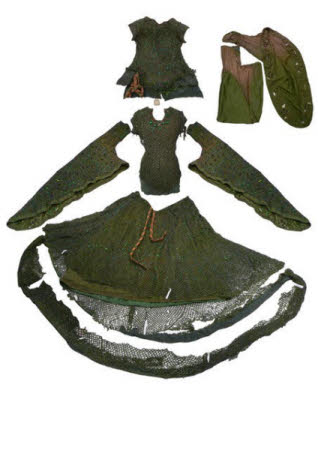‘Beetle Wing Dress’ for Lady Macbeth
Alice Laura Vansittart Comyns Carr (1850 - 1927)
Category
Costume
Date
1888
Materials
cotton, silk, lace, beetle-wing cases, glass, metal
Place of origin
London
Order this imageCollection
Smallhythe Place, Kent
NT 1118839
Caption
This shimmering emerald-green dress, embroidered with iridescent beetle-wing cases, was created for Shakespeare’s villainess, Lady Macbeth. It was worn by the famous actress Ellen Terry (1847–1928) at the opening of Macbeth at the Lyceum Theatre in London in December 1888. Designed by Alice Laura Comyns-Carr (1850– 1927) and made by Adaline Cort Nettleship (1856–1932), the dress was designed to invoke fear. The addition of beetle-wing cases created the effect of scales, perfecting the terrifying spectacle. The whole outfit, which included a purple velvet cloak, contrasted with Terry’s long, dark red hair, which was plaited with gold. Starring opposite Terry was her long-time acting partner Henry Irving (1838–1905), and the play was one of the theatrical highlights of the 1888 social season. Terry’s performance and its powerful visual impact were immortalised the following year in a painting by the artist John Singer Sargent (Tate).
Summary
The ‘Beetle Wing Dress’ worn by actress Ellen Terry (1847–1928) for her portrayal of Lady Macbeth in Henry Irving’s production of Macbeth at the Lyceum Theatre, London in 1888 – 1889. The dress consists of a knitted bodice, crochet sleeves and skirt lined with a plain-weave silk. The dress is embellished with green iridescent beetle-wing cases designed to shimmer under stage lighting. The costume is accessorised with a bejewelled heather coloured cloak, costume jewellery, a belt and a hanging scabbard and knife. Terry had a separate costume team from the rest of the Lyceum company: the designer Alice Laura Comyns-Carr (1850– 1927) and dressmaker Adaline Cort Nettleship (1856–1932). Comyns-Carr’s design shows the influence of the work of contemporary artists such as Edward Burne-Jones (1833-98) who was her close associate but also references historical dress sources including an engraving of the gothic sculpture of Clotilde, queen of the Franks from Notre-Dame de Paris by Eugène Viollet-le-Duc (1814-79), a copy of which Terry pasted into the back of her working script.
Full description
On 29 December 1888 a packed auditorium at London’s Lyceum Theatre sat in anticipation of the opening of Henry Irving’s revival of Macbeth. In taking the male lead and casting Ellen Terry (1847-1928) as Lady Macbeth, Irving was reuniting one of British theatre’s most cherished acting partnerships. Moreover, audience curiosity was piqued by Terry’s departure from her usual role of Shakespearean heroine to play a plotting villainess. As the curtain rose, her appearance on stage immediately drew gasps. For she emerged wearing a costume of bewitching splendour, a dress of shimmering green embellished with iridescent beetle-wing cases, finished with a velvet heather-coloured cloak over which her dark red hair, plaited in gold, cascaded. Created by the esteemed costume designer Alice Laura Comyns-Carr and her dressmaker Ada Cort Nettleship, it was the first of three costumes intended to illustrate Lady Macbeth’s changing psychological state through the play. Inspired by a medieval effigy of Clotilde, queen of the Franks originally from Notre-Dame de Paris, Comyns-Carr combined the form of her open sleeved long gown and long braided hair surmounted by a crown with contemporary influences of artists in her circle, such as the Pre-Raphaelite painter Edward Burne-Jones. The dress’s green embodied the ruthless ambition and plot to murder of the play’s opening acts, while the crochet construction overlaid with beetle-wing cases combined the look of ‘soft chain armour’, with the ‘appearance of the scales of a serpent’. Although critics and theatregoers were divided over Terry’s characterisation, they were united on the visual impact of her performance. Her costume created an ethereal vision that ‘might have stood in the court of Camelot’. Oscar Wilde, noting the contrast between her dress and the austere garb of the male cast, quipped ‘Lady Macbeth seems an economical housekeeper, and evidently patronises local industries for her husband’s clothes and the servants’ liveries; but she takes care to do her own shopping in Byzantium’. The dress was further immortalised in John Singer Sargent’s commanding full-length portrait of Terry as Lady Macbeth in 1889 which pictured the dramatic moment Lady Macbeth claims her crown as witnessed by him on opening night.
Provenance
By descent to Edith Craig in 1928; the house and collections were given to the National Trust in 1939.
Makers and roles
Alice Laura Vansittart Comyns Carr (1850 - 1927), designer Adaline Cort Nettleship (1856-1932), dressmaker
References
Barratt 2011: Siobhan Barratt, 'Thousands of Irridescent Beetle Wings - Conserving Ellen Terry's iconic and celebrated Lady Macbeth costume', National Trust Arts/Buildings/Collections Bulletin, Summer Issue, July 2011, p.3 Slocombe 2011. Slocombe, E., ‘Lady Macbeth at the Lyceum’, in 'Historic Houses and Collections', 2011, pp. 4-11. Slocombe & Tinker, 2016. Slocombe, E. & Tinker, Z., ‘Dress in the Limelight’, in Brookes, M. M. & Eastop, D.D., 'Refashioning and Redress', Los Angeles, 2016 Antrobus and Slocombe 2025: Helen Antrobus and Emma Slocombe, 100 Things to Wear: Fashion from the collections of the National Trust, National Trust 2025, p. 14.












